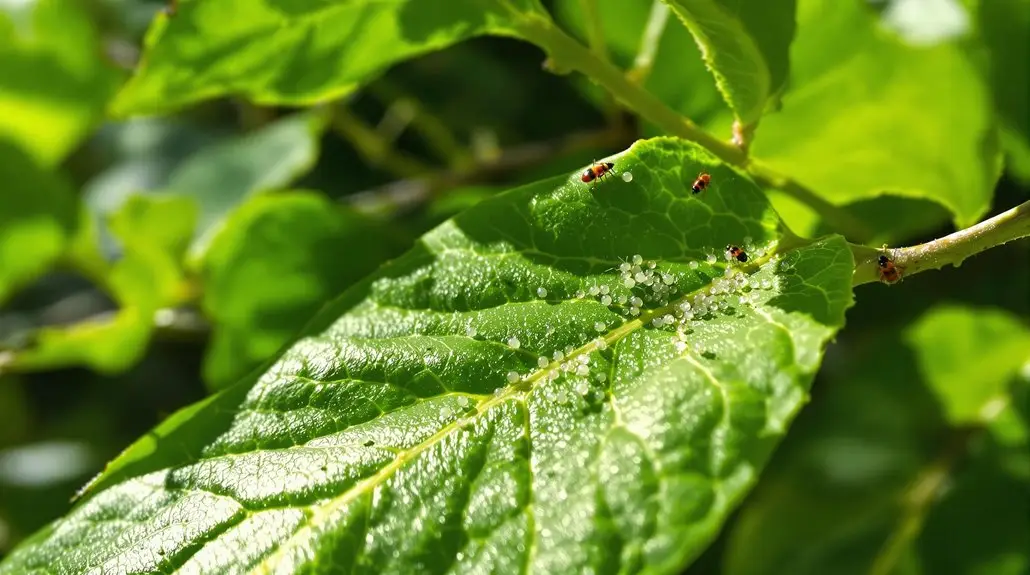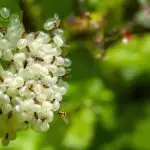Natural enemies like ladybird beetles and parasitic wasps are essential for managing the invasion of the fig whitefly, Singhiella simplex, which affects Ficus benjamina hedges in South Florida. These natural predators contribute to effective biological control methods, reducing reliance on chemical pesticides and supporting sustainable pest management. Their role emphasizes the importance of habitat preservation and integrated pest management practices that utilize these beneficial organisms. Discovering more about these strategies can enhance your understanding of effective pest control.
Key Insights
- Natural predators like ladybird beetles and parasitoid wasps play a crucial role in controlling fig whitefly populations in Ficus benjamina hedges.
- Integrated Pest Management (IPM) strategies combine natural enemies, monitoring, and targeted treatments for effective fig whitefly management.
- Fungal biopesticides, such as *Isaria fumosorosea*, offer a sustainable approach to managing fig whitefly infestations without harming beneficial organisms.
- Habitat preservation supports the populations of natural predators, enhancing their effectiveness against fig whitefly invasions.
- Regular monitoring and eco-friendly control measures are essential to mitigate fig whitefly damage in ornamental landscapes.
Overview of the Fig Whitefly and Its Hosts
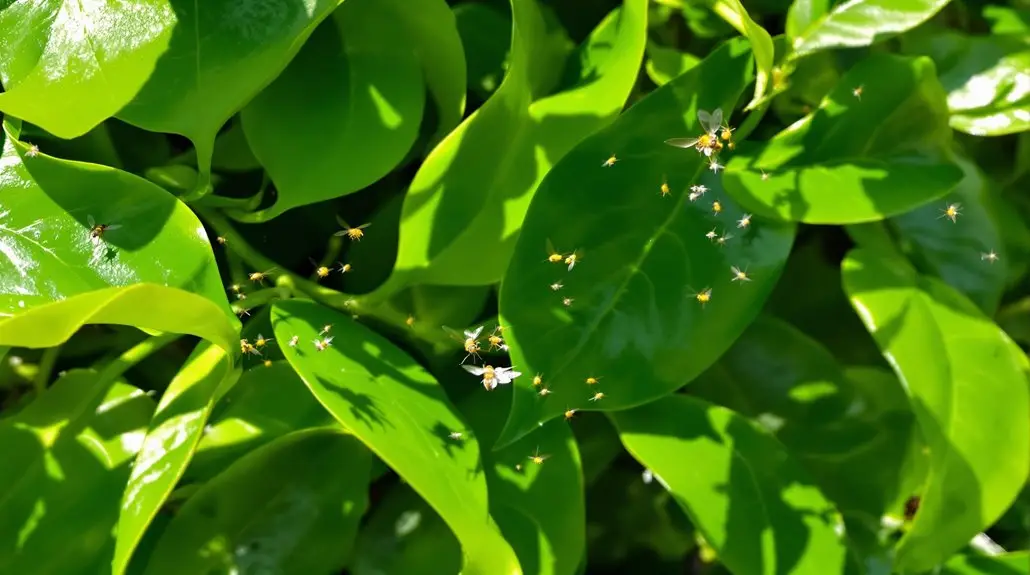
The fig whitefly, scientifically known as *Siphoninus phillyreae*, has emerged as a significant pest since its introduction to the United States, particularly affecting various species within the Ficus genus, with the weeping fig (*Ficus benjamina*) being the most commonly infested. Native to southeastern Asia, this pest was first detected in Florida in 2007 and later in California in 2012, spreading rapidly across Florida and impacting numerous Ficus species. Besides the weeping fig, it may also infest F. altissima, F. aurea, and other Ficus varieties, and occasionally affects azaleas. Its presence is widespread in urban landscapes, particularly in South Florida, where it poses substantial economic impacts due to defoliation and increased maintenance costs for affected ornamental trees. The importance of preserving natural enemies is emphasized to inform pest management strategies against this invasive species.
Identifying the Fig Whitefly Life Cycle
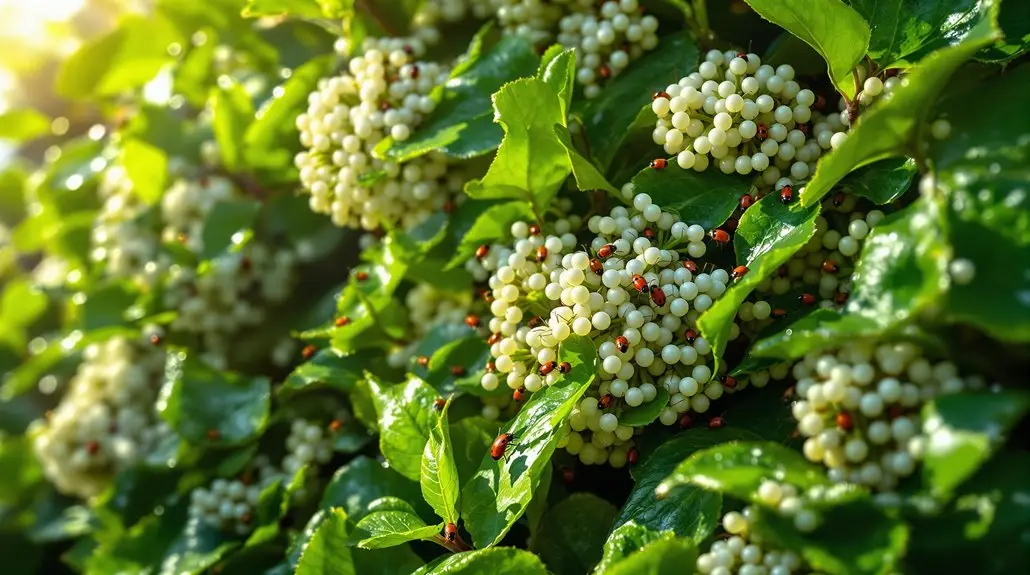
Identifying the life cycle of the fig whitefly, *Siphoninus phillyreae*, is crucial for effective management of this pest, as each stage plays a crucial role in its population dynamics. The life cycle typically lasts about 30 days under ideal temperatures of 25°C to 30°C. The process begins with eggs laid on the underside of leaves, hatching after approximately 11 days. Nymphs, which are initially mobile, remain immobile as they mature, feeding on the leaf for about 19-20 days. The pupal stage follows, lasting a shorter duration, during which the adult develops. Finally, adults emerge, reproduce quickly, and contribute to overlapping generations, which greatly impacts infestation levels. Understanding these stages helps in implementing effective control strategies, as the fig whitefly is a major pest that can cause significant damage to Ficus species.
Damage Caused by Fig Whitefly Infestations
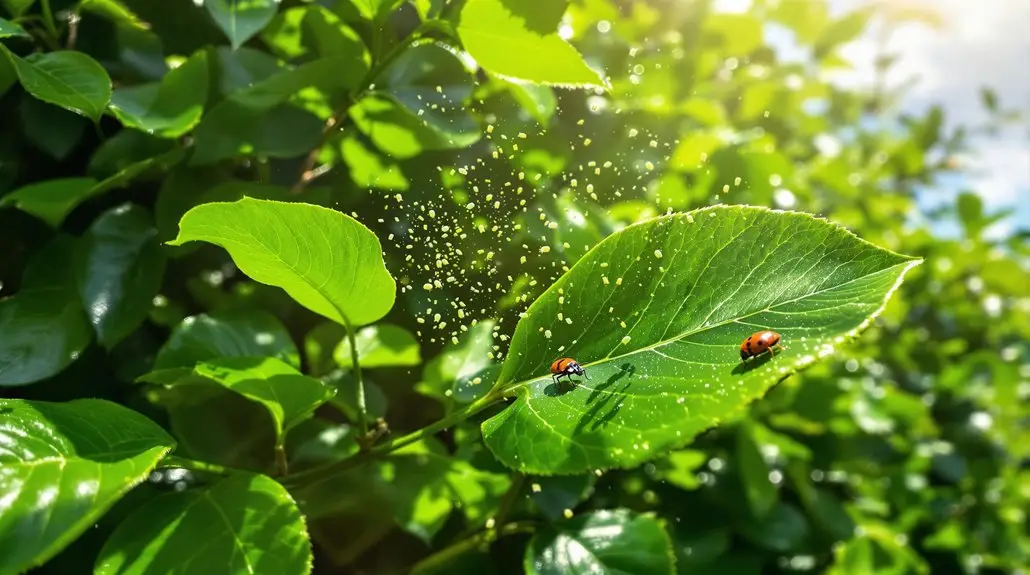
When fig whiteflies infest plants, you’ll likely notice leaf yellowing and eventual drop, which signals a decline in plant health. This damage not only weakens the plants due to the whiteflies’ sap-sucking behavior but can also lead to significant economic losses for nurseries and landscaping businesses that rely on healthy specimens. Understanding the impacts of these pests is vital for implementing effective management strategies to protect your plants and investments. Prolonged infestation can result in plant death, making it essential to address these outbreaks promptly.
Leaf Yellowing and Drop
Symptoms of leaf yellowing and drop often signal a fig whitefly infestation, indicating a serious threat to the health of affected plants. As these whiteflies feed on sap, they cause leaves, particularly those of Ficus species like *F. benjamina*, to turn yellow before dropping. This feeding leads to wilting, stunted growth, and ultimately, branch dieback. You may observe small silver or white spots on the underside of leaves, which are empty pupae skins, while adult whiteflies, identifiable by their white wings and faint gray markings, tend to fly away when disturbed. High populations of these pests can greatly hinder plant health, making early detection and management essential for preserving the overall well-being of your Ficus plants.
Economic Impact and Losses
Although fig whitefly infestations may initially seem like a localized issue, their economic impact can ripple through horticulture and local economies, greatly affecting the aesthetic value and health of ornamental plants, particularly *Ficus benjamina*. The repercussions can be significant, leading to direct financial losses for various stakeholders.
- Treatment costs for managing whitefly populations can strain budgets for gardeners and landscapers. Effective management of whitefly infestations is crucial for minimizing these treatment costs and overall plant health.
- Infestations can lower property values, as visually appealing landscapes suffer.
- Local nurseries face financial hardship if they cannot offer healthy plants, affecting their sales and sustainability.
Ultimately, these factors contribute to a broader economic disruption, impacting not only individual businesses but also the overall vibrancy of local communities reliant on healthy greenery.
Natural Predators of the Fig Whitefly
In managing fig whitefly populations, you should recognize the crucial role played by natural predators, such as ladybird beetles and parasitoid wasps. These species not only help control whitefly numbers through predation and parasitization, but they also contribute to maintaining ecological balance within their habitats. Understanding these key predatory species and implementing conservation strategies is essential for effective long-term management of fig whitefly infestations. Additionally, the Ficus whitefly’s feeding leads to copious honeydew production, which can attract more pests and complicate the management efforts. Implementing non-chemical pest control methods can further enhance the effectiveness of these natural predators in reducing pest populations.
Key Predatory Species
Understanding the key predatory species that target the fig whitefly is essential for effective pest management, as these natural enemies play a critical role in regulating whitefly populations. Several species contribute greatly to controlling these pests, including:
- Ladybird Beetles (*Harmonia axyridis*, *Olla v-nigrum*, and *Exochomus children*), which actively consume whiteflies and their eggs.
- Lacewings (*Chrysopa* spp.), known for their voracious appetite, feed on whiteflies during both larval and adult stages, greatly reducing their numbers.
- Parasitic Wasps (*Encarsia protransvena* and *Amitus bennetti*), which lay their eggs inside whiteflies, effectively disrupting their life cycles and preventing future infestations. Additionally, these predators thrive in environments where natural enemies are prevalent, enhancing their effectiveness against whitefly populations.
These predators are critical components of an integrated pest management strategy, promoting ecological balance and sustainability in South Florida landscapes.
Ecological Roles Explained
Natural predators of the fig whitefly, *Singhiella simplex*, play an important role in maintaining ecological balance within affected environments, as their presence can greatly influence the population dynamics of this invasive pest. Key natural predators, such as lady beetles and parasitic wasps, actively reduce whitefly numbers by feeding on them, while fungal pathogens like *Isaria fumosorosea* offer another layer of biological control, effectively lowering whitefly populations without harming beneficial insects. Additionally, the physical and chemical traits of host plants, including ficus leaves, can either enhance or hinder predator efficiency. Seasonal fluctuations also impact predator effectiveness, making biodiversity vital for sustainable management. To conclude, these natural enemies contribute notably to controlling fig whitefly populations and promoting ecological health.
Conservation Strategies Needed
While the conservation of natural predators is essential for managing the fig whitefly (*Singhiella simplex*), implementing effective strategies requires a thorough understanding of their ecological roles and vulnerabilities. To enhance the effectiveness of these natural enemies, you should consider the following conservation strategies:
- Habitat Preservation: Maintain natural habitats to support populations of ladybird beetles, parasitoid wasps, and lacewings, which are vital for controlling whitefly numbers.
- Selective Pesticide Use: Utilize pesticides that pose minimal harm to beneficial insects, ensuring that natural predators remain effective in managing pest populations.
- Integrated Pest Management (IPM): Adopt an IPM approach, combining natural enemies with biological control methods, such as fungal biopesticides, to achieve sustainable pest management.
Importance of Biocontrol in Managing Infestations
Biocontrol plays an essential role in managing fig whitefly infestations, as it offers a selective and environmentally sustainable approach to pest management that aligns with the principles of ecological preservation. By harnessing natural enemies, like lady beetles and parasitoids such as Encarsia protransvena, you can minimize the impact on non-target species, thereby preserving biodiversity. This method considerably reduces the reliance on chemical pesticides, promoting environmental health and human well-being. Additionally, biocontrol contributes to long-term ecosystem balance by conserving beneficial organisms while simultaneously lowering pest management costs for farmers. Overall, adopting biocontrol strategies not only effectively addresses fig whitefly populations but also supports sustainable agricultural practices and ecological integrity, making it a crucial component of modern pest management. Furthermore, biological control is particularly valuable for managing pests in ornamental plant production, enhancing both safety for people and biodiversity. NaturePest offers organic pest control services that utilize similar principles to ensure a safe and effective pest management solution.
Effective Management Strategies for Homeowners
Effective management of fig whitefly infestations requires a multifaceted approach that incorporates both monitoring and control strategies tailored for homeowners. You can effectively manage these pests by following these key strategies:
Managing fig whitefly infestations effectively involves a comprehensive strategy combining monitoring and tailored control methods for homeowners.
- Encourage Natural Predators: Introduce ladybird beetles and maintain habitats for beneficial insects like dragonflies and damselflies, which can help control whitefly populations naturally.
- Regular Monitoring: Conduct visual inspections of the undersides of leaves for whitefly presence and utilize yellow sticky traps for early detection, ensuring you check your plants weekly during the summer. These inspections are crucial because whiteflies can reproduce rapidly, with females laying up to 400 eggs at a time.
- Implement Targeted Control Measures: Use eco-friendly options like insecticidal soaps and fungal biopesticides to manage infestations while preserving beneficial organisms, ensuring a balanced ecosystem around your Ficus.
Environmental Factors Affecting Fig Whitefly Populations
Understanding the environmental factors that influence fig whitefly populations is essential for effective pest management, as these conditions greatly impact their life cycle and overall prevalence. Fig whiteflies thrive in temperatures ranging from 20 to 34 °C, with high humidity levels, particularly in the first half of the year, supporting their growth. The presence of host plants, especially *Ficus benjamina*, plays a crucial role in their survival and reproduction. Seasonal patterns indicate that populations typically surge during spring and summer. Additionally, climate change introduces weather extremes and precipitation variability, which can enhance or reduce their survival rates. These factors collectively shape the dynamics of fig whitefly populations, making understanding them fundamental for successful control strategies.
Recent Scientific Studies on Fig Whitefly Control
Recent scientific studies have shed light on various methods for controlling fig whitefly populations, emphasizing a multifaceted approach that combines biological, chemical, and ecological strategies. Researchers have identified several effective control tactics, showcasing the importance of integrating these methods for ideal results.
- Utilization of Natural Predators: Species like ladybird beetles and lacewings actively reduce whitefly numbers, enhancing biological control efforts.
- Fungal Biopesticides: The efficacy of entomopathogenic fungi, such as *Isaria fumosorosea*, demonstrates potential for sustainable whitefly management.
- Integrated Pest Management (IPM): This holistic strategy combines monitoring, cultural practices, and targeted treatments, ensuring long-term control of fig whitefly populations while minimizing ecological impact. Additionally, community awareness can significantly enhance the demand for sustainable pest control solutions.
These findings highlight the necessity of a thorough approach to effectively combat the fig whitefly invasion.
The Role of Community Action in Managing Invasions
Community action plays an essential role in managing invasions, particularly when tackling challenges posed by invasive species like the fig whitefly. Local communities contribute considerably by raising awareness through educational programs, which empower individuals to identify and address invasive species effectively. Engaging citizens in monitoring and controlling these pests enhances the overall management strategies, enabling more efficient outcomes. Collaborative efforts between municipal authorities and community members, as demonstrated in various initiatives, lead to innovative methods that minimize environmental impact, such as using biodegradable materials and planting native species. Additionally, community-driven volunteer events not only facilitate the removal of invasive species but also foster connections among participants, ultimately strengthening the collective commitment to ecosystem restoration and sustainable management practices. Expert solutions are also crucial to the success of management efforts.
Final Thoughts
The Path to Success in Fig Whitefly Management
In summary, managing the fig whitefly requires a multifaceted approach akin to traversing a complex maze; it involves understanding the life cycle, identifying natural predators, and implementing effective biocontrol strategies. Homeowners play a crucial role in this effort by maintaining healthy landscapes and supporting community initiatives. Recent research continues to shed light on effective management practices, emphasizing the importance of collaboration between scientists and the public to mitigate the impacts of this invasive pest on Ficus benjamina hedges.
Conquer the Fig Whitefly Challenge!
Join the fight against the fig whitefly in South Florida! We at NaturePest Holistic Pest Control are dedicated to providing you with the tools and knowledge necessary to protect your landscapes. Together, we can develop a sustainable plan that not only preserves the beauty of your Ficus benjamina hedges but also supports the environment. Don’t wait for the infestation to worsen—reach out to us today and be part of the solution!

